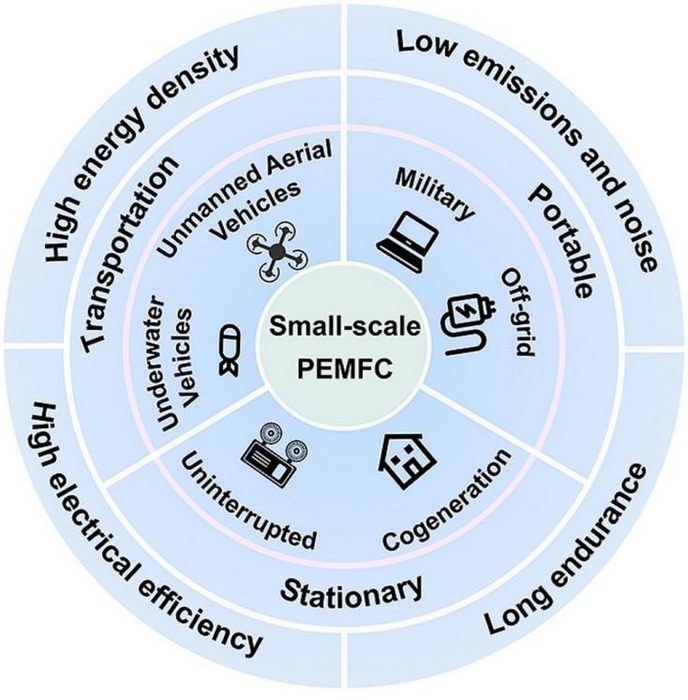Global renewable energy commercialization has accelerated due to rising environmental and climate change awareness. Naturally, there is a greater need to power a variety of compact and low-power devices.
 A review by Tianjin University researchers provides a holistic overview of the applications of small-scale PEMFCs in transportation, and stationary and portable power generation fields, including essential strategies to improve their efficiency and marketability. Image Credit: Kui Jiao from Tianjin University Image source Link: https://doi.org/10.1016/j.enrev.2023.100017
A review by Tianjin University researchers provides a holistic overview of the applications of small-scale PEMFCs in transportation, and stationary and portable power generation fields, including essential strategies to improve their efficiency and marketability. Image Credit: Kui Jiao from Tianjin University Image source Link: https://doi.org/10.1016/j.enrev.2023.100017
The idea of producing energy from hydrogen using fuel cells is being encouraged by limitations in small-scale electricity storage.
Electrochemical cells that convert fuel’s chemical energy into electrical energy are called proton exchange membrane fuel cells (PEMFCs). PEMFCs have a variety of uses, but they are particularly well suited for small-scale applications due to their distinctive characteristics, such as high energy densities, minimal pollutant emissions, and low operating temperatures.
For applications including portable power generation, unmanned aerial vehicles (UAV), light-duty vehicles, and residential power supply, the small-scale PEMFC (10 kW) is particularly suitable. Notably, advances in the small-scale PEMFC technology’s specific power can increase the commercial acceptance of this cell.
Professor Kui Jiao and his colleagues from Tianjin University in China examined the developments and challenges facing PEMFC applications to comprehend the present trends in this sector. The results were published in Volume 2 of Energy Reviews on April 18th, 2023, and were made available online.
The group analyzes the functionality and properties of PEMFCs for use in stationary, portable, and transportation-related applications in the review article. Additionally, they offer their opinions on potential future plans for compact PEMFC systems with high specific power.
Small-scale PEMFCs have the potential to be an ideal alternative power source for traction vehicles, underwater vehicles, and unmanned aerial systems (UAVs) in the transportation sector.
The researchers also noted that PEMFC range extenders and mild hybrid designs with a higher power density and longer endurance are better suited for small transportation applications.
Small-scale PEMFCs are also employed for stationary uses, including residential cogeneration systems and uninterruptible power supplies. Reliability, durability, and affordability are prerequisites for these power systems.
In this regard, the study team came to the conclusion that the PEMFC, due to its high efficiency and minimal pollutant emissions, could be employed as a renewable backup power source. Concerns about fuel dependability and flexibility were also addressed.
It should be noted that small-scale PEMFCs offer additional advantages despite the fact that lithium (Li)-ion battery systems dominate the market for portable applications. Small-scale PEMFCs are ideal for portable (outdoor) power production because of their extended duration, high energy density, off-grid power generation, and versatility.
Although several pioneering studies have been conducted to promote the application of small PEMFCs, further advancements are essential to meet the requirements for practical applications.
Kui Jiao, Professor, Tianjin University
The optimization of fuel cell materials and system design to produce a high-specific power fuel cell will be the major future difficulties in the development of small-scale PEMFCs.
By improving the structural material design for improved dependability, lightweight components are essential for developing new, high-performance PEMFC technologies. Utilizing portable hybrid power sources for an immediate power surge can reduce the reaction time of PEMFCs.
Additionally, effective energy management techniques for hybrid power sources aid in enhancing their dynamics and efficiency.
Prof. Jiao added, “A hydrogen storage system with a high hydrogen storage density, quick hydrogen release and charge rates, strong reversibility, and improved safety is crucial for increasing the overall device-level energy density of small-scale PEMFC systems.”
Therefore, a large volume of compressed gas storage tank would not be useful for small-scale PEMFC applications where weight and space are crucial factors.
“Conversely, a long-term hydrogen storage system for small-scale PEMFC applications may instead be based on materials such as complex hydrides and metal storage systems with high volumetric densities,” Prof. Jiao concluded.
Journal Reference:
Wang, Z., et al. (2023) Application progress of small-scale proton exchange membrane fuel cell. Energy Reviews. doi:10.1016/j.enrev.2023.100017